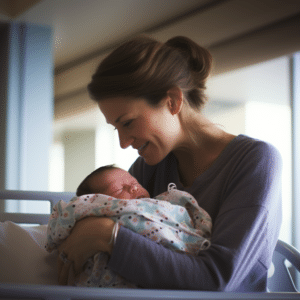
Navigating Childbirth: Options, Benefits, and Risks Explored
Childbirth is a big deal for women. Choosing the right option is vital. This article will provide info on the benefits and drawbacks of different childbirth options. Let’s explore them!
Natural childbirth is a popular choice. It offers an organic experience without medical interventions. Mothers have a sense of control and power. But it can be tough, with intense pain.
Medication is another option. Epidurals numb the lower body while keeping you awake. But they can have side effects and a longer recovery time.
C-sections are sometimes necessary due to complications or existing conditions. This involves an incision in the abdomen and uterus. It reduces certain risks but has higher risks of infection and longer stays in the hospital.
Pro Tip: Talk to your healthcare provider about your birth plan beforehand. Make an informed decision based on your individual needs and wants.
Benefits and Risks of Natural Childbirth

To understand the benefits and risks of natural childbirth, dive into the realm of this childbirth method. Discover the advantages of natural childbirth and become aware of the potential risks it presents. Uncover the sub-sections: “Benefits of Natural Childbirth” and “Risks of Natural Childbirth” for a comprehensive view of this option.
Sub-Heading: Benefits of Natural Childbirth
Natural childbirth offers many advantages for both mothers and babies. Here are 5 of them:
- Lower risk of issues. Natural childbirth reduces the need for medical interventions like C-sections, which may cause problems.
- Quicker recovery. Natural childbirth leads to faster healing compared to epidurals or C-sections.
- Enhanced bonding. The birthing process releases hormones that build a strong emotional connection between mother and baby.
- More control. Women who choose natural childbirth often feel more in charge of their birthing experience.
- Better breastfeeding. Natural childbirth stimulates hormones that make breastfeeding easier.
Other aspects of natural childbirth are also worth considering. For example, partners or support persons can be more involved in labor. Plus, some women find satisfaction in feeling their body’s strength and resilience.
When making your birthing choices, don’t forget about the benefits of natural childbirth. It can lead to an uncomplicated delivery, plus lasting memories of love and empowerment. So, choose natural childbirth to have a remarkable and empowering birth experience.
Sub-Heading: Risks of Natural Childbirth
Risks of Natural Childbirth
Natural childbirth may be a preferred option for many women, yet it has risks to consider. Here are three points:
- Pain: Natural childbirth can be painful and uncomfortable as the body goes through labor and delivery.
- Complications: Without medical help, there is a higher risk of complications. These can include bleeding, infection, or damage to the birth canal.
- Longer recovery: Recovering from natural childbirth can take longer than other methods. It involves healing from any tears or cuts that may have happened during delivery.
Every birthing experience is unique. Unexpected complications may arise. Knowing the risks helps expectant mothers make informed decisions about their birthing plan.
Sarah opted for a natural childbirth despite the potential risks. During her labor, she had prolonged and intense pain due to a difficult delivery. She gave birth naturally and experienced severe tears requiring surgical repair post-delivery. This is a reminder that even with preparation and understanding, unexpected challenges may occur during natural childbirth.
Benefits and Risks of Medicated Childbirth
To better understand the benefits and risks of medicated childbirth, let’s explore the sub-sections: Benefits of Medicated Childbirth and Risks of Medicated Childbirth. These sub-sections will shed light on the advantages and potential drawbacks associated with opting for medication during the childbirth process.
Sub-Heading: Benefits of Medicated Childbirth
Medicated childbirth presents unique benefits for mothers and infants. Pain relief is effective, allowing for a more comfortable birthing experience. Epidurals reduce labor pains, so women don’t have to use as much energy when pushing during delivery. This leads to shorter labor times and less complications.
Plus, medicated childbirth offers numerous perks. Medical professionals can monitor mothers and babies closely, ensuring their well-being. Medications used can be tailored to individual needs for personalized care.
Queen Victoria popularized the use of chloroform during her deliveries in the mid-19th century. This decision revolutionized childbirth practices and still positively impacts maternal care today.
Sub-Heading: Risks of Medicated Childbirth
Medicated childbirth has risks. Possible side effects include nausea, vomiting, and drowsiness. This can stop a mom from being involved in their baby’s birth and bonding. Medication may also cause interventions like forceps or vacuum extraction, which have their own risks.
Plus, meds might make labor longer. Pain relief may help, but it could slow contractions and add stress. Medication can also pass into breast milk and affect the newborn’s alertness and feeding.
To lower risks, consider non-medicated pain management. These can include breathing exercises, relaxation, massage, water immersion, and acupressure.
Also, talk to a healthcare provider about risks and benefits before deciding on medicated childbirth. This helps moms make an informed decision.
Benefits and Risks of Cesarean Section
To understand the benefits and risks of cesarean section, dive into the sub-sections. Discover the advantages of cesarean section, including controlled delivery and reduced risk of birth injuries. Explore the potential risks associated with this procedure, such as infection and longer recovery time.
Sub-Heading: Benefits of Cesarean Section
Cesarean section, otherwise known as C-section, has many advantages for mums and babies alike. It is often chosen when a vaginal birth may contain risks or complications. Here are some of its key benefits:
- Lower risk of harm to baby: C-section can help avoid traumas that can be caused during a tough vaginal delivery.
- Decrease in infections: Compared to vaginal birth, cesarean section lowers the chances of maternal infections such as postpartum endometritis.
- Chosen time: Cesarean sections allow for arranged births, which may be beneficial in certain medical conditions or situations where planning is preferred.
- Possible prevention of incontinence: Women who have had multiple vaginal deliveries may develop urinary incontinence later in life, while C-sections can stop this.
- Reduced damage to pelvic tissues: Unlike vaginal delivery, cesarean section limits trauma to the pelvic floor muscles and ligaments.
- Prevention of fetal distress: In cases where there are worries about the baby’s health during labor, a C-section can quickly deliver the baby, minimizing the risk of distress or hypoxia.
It is essential to note that cesarean sections come with their own set of risks and should only be thought about when medically necessary. Healthcare providers must thoroughly look at each individual case before recommending this procedure.
A remarkable historical example to show the importance of cesarean section dates back to the late 19th century. Dr. Ferdinand Adolf Kehrer performed one of the earliest known emergency C-sections, which saved the lives of both mother and baby. This innovative procedure revolutionized obstetric practices and opened doors to more advances in surgical techniques.
Ultimately, while cesarean sections provide benefits such as lowered birth trauma and chosen timing, it is vital to properly weigh the pros and cons and think over individual circumstances before making a decision. Medical professionals play an important role in assisting expectant mothers through this process, guaranteeing the best possible outcome for both mother and baby.
Sub-Heading: Risks of Cesarean Section

Cesarean section is common – but it carries risks. These could happen during the procedure itself, or in recovery. It’s important to know the possible complications to make an informed choice about childbirth.
- Uterine infection: There’s an increased risk of this after a c-section. Medication can reduce this.
- Blood loss: As with any surgery, too much bleeding can occur – sometimes requiring transfusions.
- Anesthesia: This can cause allergic reactions or other issues.
- Delayed recovery: This takes longer than with vaginal birth. Plus, it takes time for the incision site to heal.
- Future complications: Women who’ve had a c-section may have an increased risk of placenta previa or uterine rupture in future pregnancies.
- Emotional impact: Feeling disappointed, or guilty, is possible if opting for a c-section when hoping for vaginal birth.
When considering the potential issues of c-section, it’s essential to know individual circumstances and health history. Sarah Murray, 34, opted for a planned c-section due to a previous complicated delivery. But, she experienced heavy blood loss during the procedure and needed urgent transfusion. This tricky road to recovery shows the importance of acknowledging and preparing for c-section risks.
In conclusion, it’s vital for expectant mothers and medical professionals to be aware of the benefits and risks of c-section. This enables informed decisions, to achieve the best outcome for mother and baby.
Conclusion
When thinking of childbirth, each one’s needs and wants are unique. Weighing the pros and cons of each choice is key for expectant parents. Natural birth, water birth, and medical interventions all have benefits and risks.
Natural birth lets the body do its thing without medical help. This could lead to a sense of power and a fast recovery. But, it could also mean more pain.
Water birth might provide a calming atmosphere and relief from labor pain. But, there’s a chance of infection if not done in a controlled setting.
Medical interventions such as C-section and epidural anesthesia can help with pain and can even save lives. But, there’s a risk of surgery complications or reduced mobility afterwards.
Consulting experts and considering personal factors is important when making a childbirth decision. Take Maria’s experience, for instance. At first, she was hesitant about medical interventions but went with a planned C-section because of health concerns. This led to a safe delivery and a stronger bond with her healthcare team.
No single approach fits everyone. Weigh the pros and cons based on your situation, and get advice from experts to make a choice that fits your individual needs and wants.
Frequently Asked Questions
FAQs about the benefits and risks of each childbirth option:
Q: What are the benefits of vaginal birth?
A: Vaginal birth can offer several benefits, including a shorter recovery time, reduced risk of infection, and a lower chance of respiratory problems in the baby.
Q: What are the risks of vaginal birth?
A: While vaginal birth is generally safe, some potential risks include tearing, perineal pain, and pelvic floor disorders. Complications may also arise if there are underlying medical conditions.
Q: What are the benefits of a cesarean section (C-section)?
A: A C-section can be necessary for various reasons and can help in cases where vaginal birth might pose risks. It allows for a controlled delivery, minimizing risks of injury to the baby and ensuring a safer outcome for certain medical conditions.
Q: What are the risks of a cesarean section (C-section)?
A: C-sections involve surgical procedures and, like any surgery, carry risks such as infection, blood loss, and anesthesia complications. Recovery time is typically longer compared to vaginal birth, and there may be potential risks for future pregnancies.
Q: What are the benefits of a home birth?
A: Home births offer a comfortable and familiar environment for the mother. They promote a sense of control and can lead to fewer medical interventions and a lower likelihood of medical complications.
Q: What are the risks of a home birth?
A: Some risks associated with home births include the possibility of emergency situations requiring immediate medical attention, limited access to medical interventions, and potential complications for both the mother and the baby if unexpected issues arise.